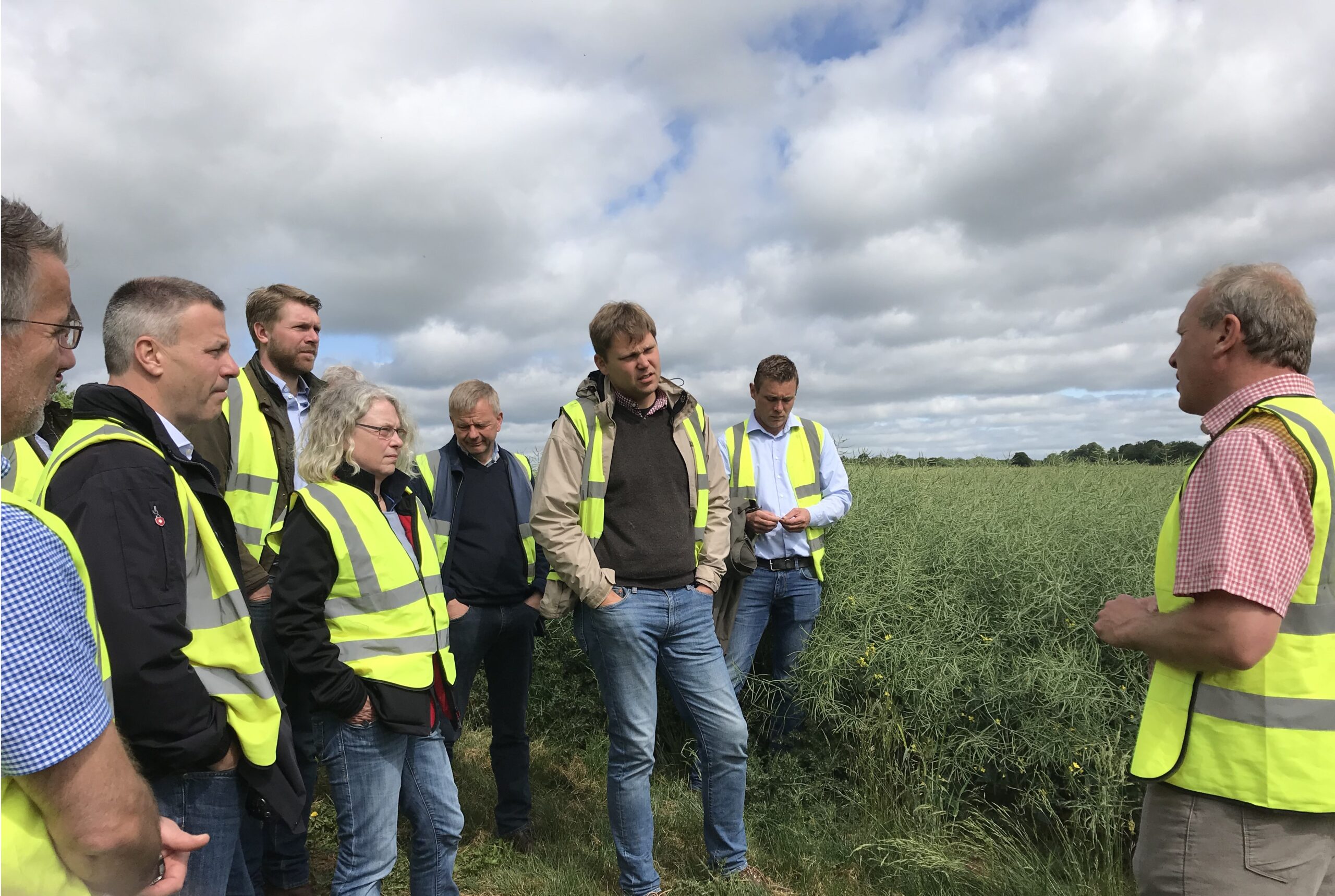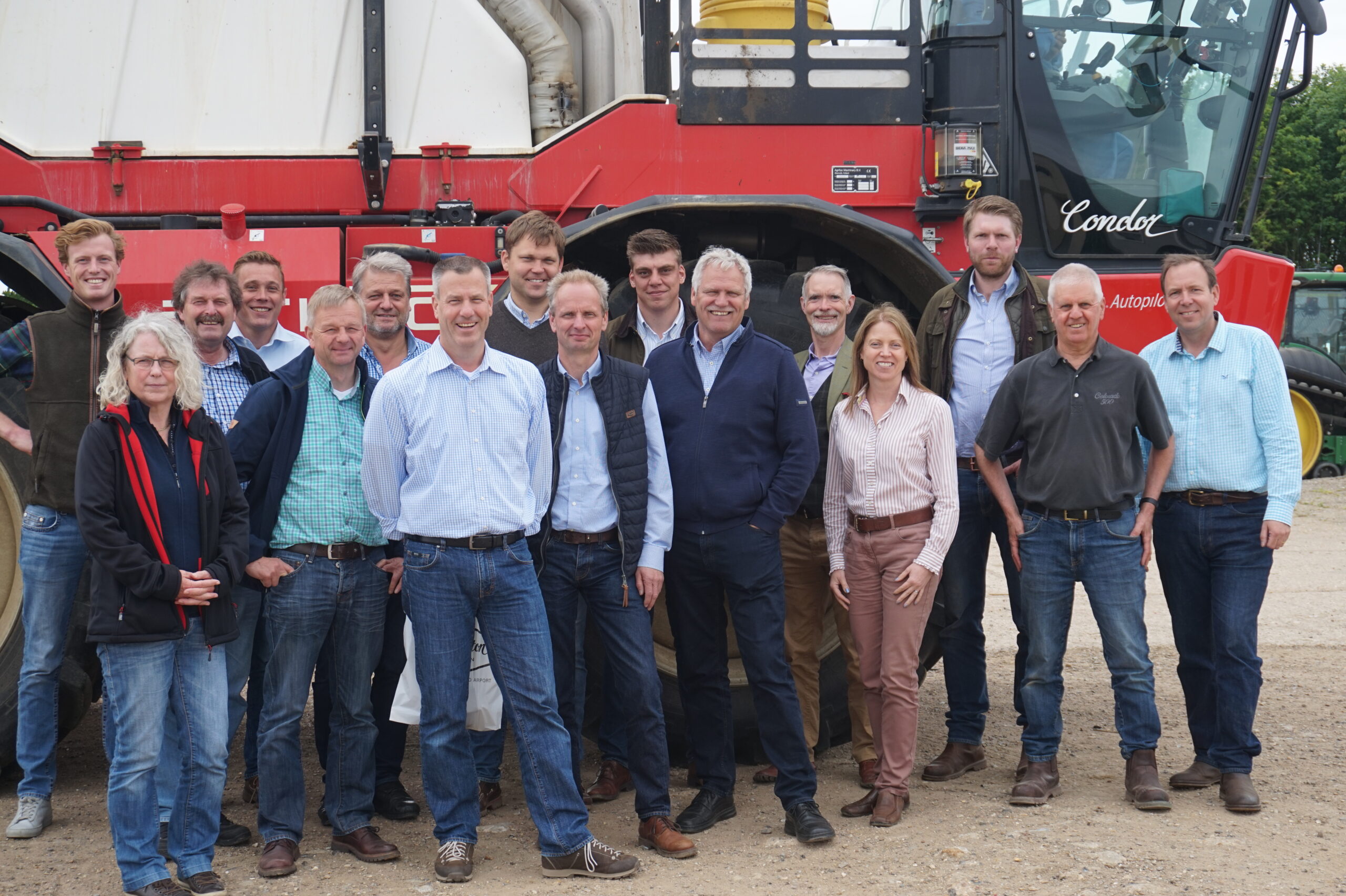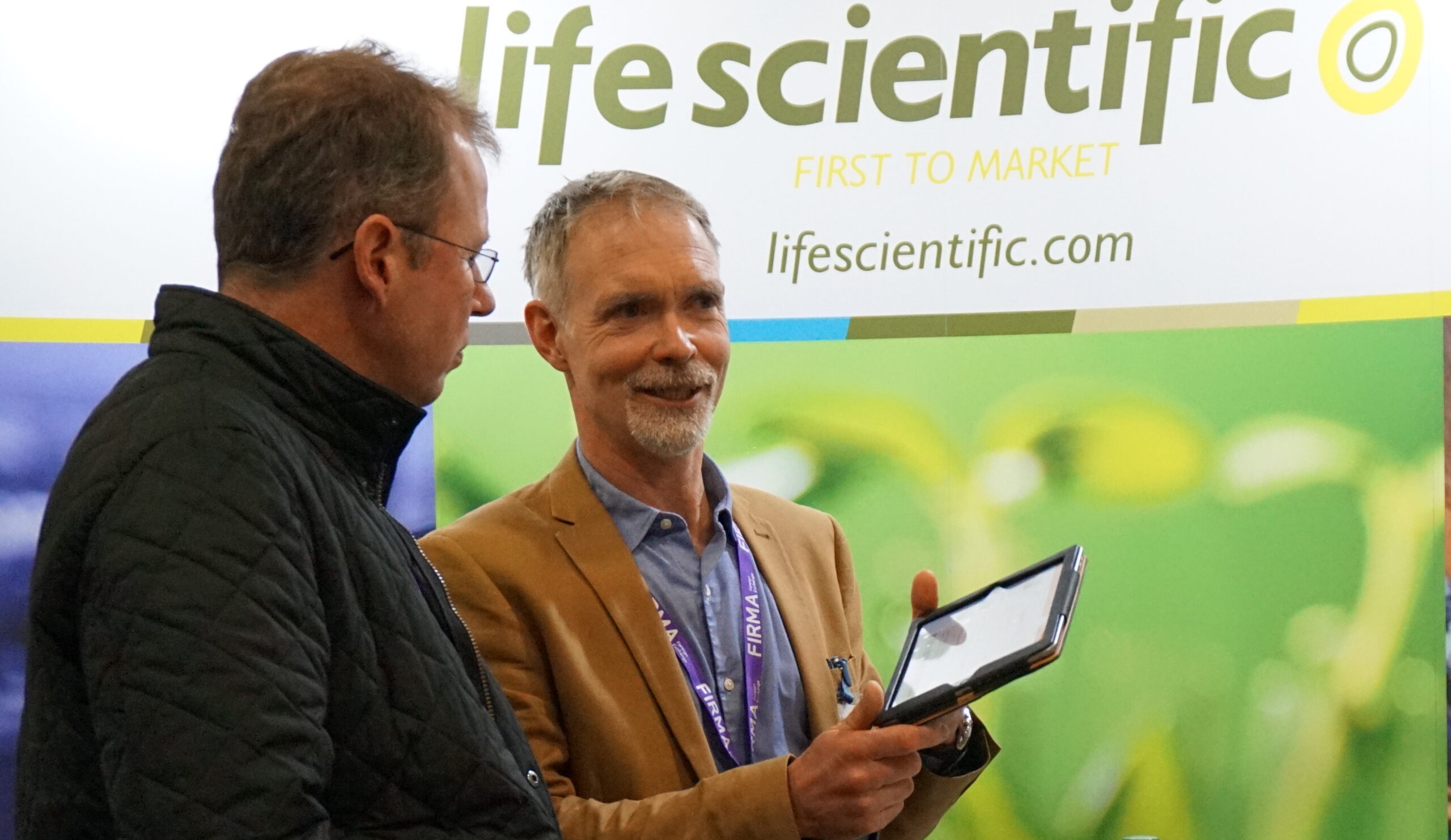See our June newsletter for up to date news and information.
Life Scientific Newsletter June 2019


See our June newsletter for up to date news and information.

A group of German arable farmers have come to the UK to look at the methods that UK growers are taking to control black-grass.
Organised by Ruth Stanley, UK technical manager for Life Scientific, the key message for the German visitors was that UK growers could no longer depend solely on chemistry to control difficult black-grass due to extensive resistance, so a range of cultural methodologies was now essential to ensure optimum herbicide efficiency.
“We are seeing black-grass resistance creep into our crops, and we know that if we don’t do anything about it we will face similar issues, so we have a lot to learn from UK farmers,“ explained Stefan Knittel, German country manager for Life Scientific, who accompanied the visitors.
The 10 arable farmers are from the Shleswig Holstein region of northern Germany where the climate is fairly similar to that of the UK.
“We are near the sea so its mild and warm in winter, and we have plenty of moisture combined with heavy soils – so ideal conditions for black-grass to flourish.”
“Rotations in the region tend to be one in four; the key focus is wheat and usually also includes oilseed rape and a barley or maize spring crop. “
“By having the spring crop, many growers are able to keep on top of the black-grass to a degree, but we need to do more and this is what we hope to take away from this trip.”
“We also don’t have the levels of resistance to chemistry that face UK growers, so we would not need to rely on glyphosate to the same level for desiccation or stale seed beds.”
A morning spent on the 5000 ha Thurlow Estate on Cambridgeshire/Suffolk border where there is a zero black-grass tolerance provided a good starting point for the tour.
A normal black-grass herbicide programme on wheat would include pre and peri-emergence herbicides in the autumn and then, where required, a spring herbicide application, pointed out farm manager, Jonathan Drury.
However, he added that cultural methods of control are key to ensuring optimum herbicide efficacy, pointing out the range of cultural measures taken to combat black-grass at Thurlow which include:
The group also had a talk from leading black-grass expert, Dr Stephen Moss on the physiology of black-grass and methods for control, and spent some time with grower Russ McKenzie on how he manages black-grass on his farm.
The German farmers also visited an AHDB Monitor Farm belonging to Rob Fox in Leamington Spa. Here they were able to compare UK and German costs of production, which turned out to be broadly similar.
A morning spent at Great Tew Estate provided the chance to look at wheat and barley variety trials, both treated and untreated. They were very interested to hear that Azoxystar had been used twice in one of the programmes for the additional greening and plant health benefits.
A visit to the Hutchinsons Helix site provided a look at more strategic farm solutions, with particular interest in TerraMap, a non-invasive soil scanning service that has just been launched in the UK.
“The trip was really fascinating, and the positive spirit of the UK growers came across clearly. The growers took away a lot from UK farming, that can be used in Germany, such as the high levels of technical expertise around spraying and grain storage. It was also really interesting to see the ecological aspects of farming in the UK which differ from the biodiversity actions which are common practice in Germany,” explained Stefan.
“Overall, its been very impressive to hear the extent of practices that UK farmers go to in order to manage black-grass and the need for a long term sustainable yield an not a short term goal.”

See our May 2019 Newsletter for up to date news and information from Life Scientific.

See our April 2019 newsletter for all the latest news and information from Life Scientific.

A Nottinghamshire farm is hosting field scale trials looking at cost-effective options for spring weed control.
The trial being run at Poole Farms, Southwell in Nottinghamshire is comparing the performance and overall cost-effectiveness of two mesosulfuron +iodosulfuron based herbicides Pacifica and Cintac, as well as aiming to gain some insight into the most cost -effective adjuvant partners.
Cintac and sister product Niantic were the first off-patent mesosulfuron + iodosulfuron herbicides to be available to the UK arable market. Manufactured by Dublin based off-patent manufacturer Life Scientific, Cintac is produced by the unique process of reverse engineering.
“This is the ability to clone a product from the original resulting in a product accepted as comparable by the regulatory authority (Chemical Regulation Division) – which means it is the same as the reference product – and in the case of Cintac this is Pacifica,” explains Ruth Stanley, technical manager for Life Scientific.
She recognises the difficulty that whilst the product is recognised as comparable by CRD, many agronomists and growers want to see how it performs in the field.
“This is what we hope to demonstrate in this trial.”
Working together with farm contractor Alastair Baseley of JS Peak & Sons and agronomist Martin Hoggard of ProCam, the trials are spread across two separate fields .
The trial area is just short of 10ha and is being run on a split field trial basis on a field of Graham winter wheat, explains Martin Hoggard.
He points out that there are heavy black-grass populations across both fields, along with a smattering of brome and various broad leaved weeds.
“However we have gone on with a pretty hefty pre-emergence programme so if we get onto the black-grass early enough it will be interesting to see what control we get. We have not used any sulfonyl-urea based herbicides on these fields for a couple of years.”
“The crop had also had an application of 0.5l/ha of Pontos (flufenacet + picolinafen) post-emergence at growth stage 11.”
Mrs Stanley adds that the herbicides will mop any of the broad leaved weeds such as chickweed, and volunteer OSR as well as brome and wild oats that are also present.
The first trial will compare the performance of Pacifica and Cintac directly. Both products will be tank mixed with the adjuvant Cogent.
“We are not expecting to see any differences in control between the Pacifica and Cintac – that’s the whole point of the trial – as the products are the same!”
“What we will demonstrate is that the level of control from the Cintac is the same as that offered by the Pacifica.”
“We will leave an unsprayed strip to allow us a comparison with treated and untreated.”
Mrs Stanley will be carrying out plant counts of existing weeds before and after spraying to ascertain exact numbers.
The second trial will look at how Pacifica and Cintac compare when mixed with different adjuvants; the Pacifica will be mixed with BioPower and the Cintac with Cogent.
We will compare the differences in these treatments, she adds.
By demonstrating that Cintac offers the same levels of control as Pacifica, and at a more cost effective price it opens up the market-place to more choice for growers and agronomists, she points out.
“Its also worth noting that authorisation for Pacifica use expires on 30 April 2020, with all sales and distribution needing to happen before 30 April 2019, however this is not the case with Cintac which does not carry any expiry on authorisation of use.”
Getting the most out of spring spraying with independent expert Tom Robinson
Last year independent spray expert Tom Robinson conducted a trial at Thurlow Estates looking at the importance of spray application technique to maximise spring weed control.
The trial evaluated spray coverage of Cintac + an adjuvant on water sensitive paper targets @GS30.
Four nozzles were compared, each at 3 different boom heights using a commercial sprayer.
Results showed that nozzle height is important for all nozzles however the coverage on vertical surfaces doubled at 40 and 50cm vs 100cm.
For the best performance the nozzle height should be no more than 50cm, noted Mr Robinson.
Nozzle height also has an effect on spray coverage, he adds.
The traditional 110° Fanjet did an acceptable job although it is sensitive to boom height and has a poor drift profile.
3D Angled spray produced the best coverage of vertical surfaces.
80° Flat fan produced the best coverage of flat surfaces.
Guardian Air was the least sensitive to nozzle height.
As blackgrass emergence in the replicated plots was too variable across the trials areas to allow differentiation of treatments by efficacy, the trial is being repeated this year.
PANEL Poole Farms Trial

New technical manager for Life Scientific Ltd.
Life Scientific Ltd. has appointed Ruth Stanley as its UK technical manager. This new role within the company reflects the growing portfolio of its unique off-patent crop protection products registered for use in the UK.
Previously Campaign Manager at BASF for cereal herbicides and PGR’s, Mrs Stanley brings a wealth of experience and first hand farming knowledge to the role, as she is an active partner in her family arable farming enterprise in Leicestershire. Mrs Stanley is also a BASIS examiner.
In her new role Mrs Stanley will be the point of contact for advisors and growers providing them with the technical support needed to fully utilise the Life Scientific product portfolio.
“I am very excited to be joining Life Scientific and believe its unique approach in bringing off-patent products to market faster than ever before, will play a crucial part in providing the solutions that UK farming businesses are looking for in order to maintain sustainability going forward.”
“Farm businesses are currently under pressure to maintain profitability in a very unsure and challenging environment, so keeping costs down without compromising yield and quality is of paramount importance,” says Mrs Stanley.
Established in 1995, Life Scientific is co-owned (50/50) by its founder and CEO, Nicola Mitchell, and by French co-op group, InVivo. The company, currently employs 60 people and has an annual turnover of €50 million.
Recent developments have also seen the appointment of a German managing director, Stefan Knittel, marking the formal entry of Life Scientific to the German market in the autumn 2018 – a key milestone in the growth of the company.
Dr Bill Lankford, Life Scientific’s UK country manager points out that the reason the company has been able to bring so many products so quickly to the UK market place is the company’s ability to reverse engineer a product from the original, meaning that the resulting product is accepted as comparable by the regulatory authority.
All of Life Scientific products will have full generic registration – there are no parallel imports.
He points out that this speed of development is a considerable competitive advantage against a background of pressure on farmers to reduce their cost of production, and on generic companies to secure a return on their investment in product development in a “highly unpredictable regulatory environment”

Croptec sees launch of innovative new products and spray application work from Life Scientific
Following on from the highly successful launch of its unique off-patent mesosulfuron + iodosulfuron products NIANTIC and CINTAC last year, Life Scientific will introduce its newest products to the UK arable market at this year’s Croptec event.
Visitors to the Life Scientific stand will have the chance to discuss these exciting new approvals with key representatives from Life Scientific and also discuss the results of its latest spray application trials.
“We are delighted to announce several new product approvals, as well as extensions of use for some established products, reflecting our continuing investment in the UK arable market,” says Bill Lankford, Life Scientific UK country manager.
REVEL (difenoconazole 250g/L EC) is a fungicide for the control of stem canker, light leaf spot, leaf and pod spot in winter and spring oilseed rape crops, as well as leaf spot and ring spot in edible brassicas.
SUMIR (florasulam 50g/L SC) is a post emergence herbicide for the control of cleavers and broad-leaved weeds in winter and spring crops of wheat, barley and oats.
“We also continue to work hard to develop additional recommendations for products already in the market place; our azoxystrobin registered product Azoxystar is now approved not just for use in cereals and potatoes, but also field beans and a wide-range of field grown vegetables.”
“Last spring Azoxystar also received an extension of authorisation for minor use (EAMU) for Sclerotinia control in soya beans.”
“Recent approval has been received for the addition of NIANTIC and CINTAC as new convenient tank mix or sequences with SUMIR.”
Life Scientific’s range of products are unique in that they are focussed on identical formulations of brand leaders and have full generic registration, there are no parallel imports points out Bill.
“The only fundamental difference to the original reference products is price; ours will cost less than the brand leader, so for growers and agronomists looking at their costs of production as we head into an era of intense financial scrutiny, we are offering crop protection solutions genuinely worthy of consideration.”
New independent trials work on nozzle selection and boom height
Since the launch of its mesosulfuron + iodosulfuron herbicides NIANTIC and CINTAC at last year’s Croptec event, Life Scientific has invested significant resource on a series of trials looking at optimising the performance of these products with regards to nozzle type and height.
Independent application expert, Tom Robinson, conducted the trials on behalf of Life Scientific.
“We tested a range of nozzles at different boom heights on black-grass, looking specifically at the coverage on vertical surfaces doubled at 40, 50cm vs 100cm using a range of nozzle types that are typically found on farm. “
“Results were very interesting and varied between nozzles and boom heights – underlining the importance for operators to fully understand how to ensure sprays hit the target to deliver the best levels of control.”
Visitors to the Life Scientific stand at Croptec will be able to see the results of these trials and discuss how to implement them on farm.
For a comprehensive list of all Life Scientific products and technical updates, please visit the Life Scientific website www.lifescientific.com